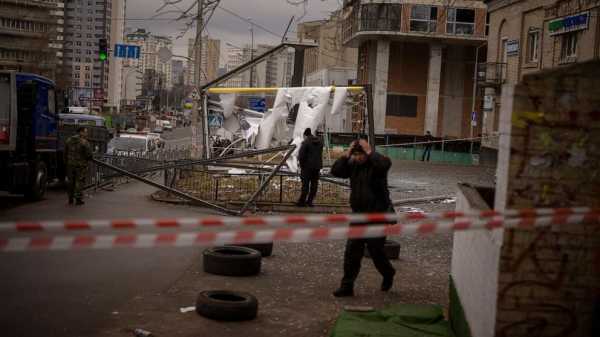
TALLINN, Estonia — On the battlefields of Ukraine, the fog of war plagues soldiers. And far from the fighting, a related and just as disorienting miasma afflicts those who seek to understand what's happening in the vast war.
Disinformation, misinformation and absent information all cloud civilians’ understanding. Officials from each side denounce devious plots being prepared by the enemy, which never materialize. They claim victories that can’t be confirmed — and stay quiet about defeats.
None of this is unique to the Russia-Ukraine conflict. Any nation at war bends the truth — to boost morale on the home front, to rally support from its allies, to try to persuade its detractors to change their stance.
But Europe’s largest land war in decades — and the biggest one since the dawn of the digital age — is taking place in a superheated information space. And modern communications technology, theoretically a force for improving public knowledge, tends to multiply the confusion because deceptions and falsehoods reach audiences instantly.
“The Russian government is trying to portray a certain version of reality, but it’s also being pumped out by the Ukrainian government and advocates for Ukraine’s cause. And those people currently also have views and are using information very effectively to try to shape all of our views of the war and its impact," says Andrew Weiss, an analyst at the Carnegie Foundation for International Peace.
THE ‘FOG’ IS NOT A NEW DEVELOPMENT
Even before the war began, confusion and contradiction were rife.
Russia, despite massing tens of thousands of soldiers on the border, claimed it had no intent of invading. Ukrainian President Volodymyr Zelenskyy consistently downplayed the likelihood of war — an alarming stance to some Western allies — although the defense of Kyiv showed Ukrainian forces were well-prepared for just that eventuality.
Within a day of the war’s start on Feb. 24, 2022, disinformation spread, notably the “Ghost of Kyiv” tale of a Ukrainian fighter pilot who shot down six Russian planes. The story’s origin is unclear, but it was quickly backed by Ukrainian official accounts before authorities admitted it was a myth.
One of the most flagrant cases of disinformation arose in the war’s second week, when a maternity hospital in the besieged city of Mariupol was bombed from the air. Images taken by a photographer for The Associated Press, which had the only foreign news team in the city, appalled the world, particularly one of a heavily pregnant woman being carried on a stretcher through the ruins.
The brutal attack flew in the face of Russian claims that it was hitting only targets of military value and was avoiding civilian facilities. Russia quickly launched a multi-pronged and less-than-coherent campaign to tamp down the outrage.
Diplomats, including Russia’s U.N. ambassador, denounced AP’s reporting and images as outright fakes. It claimed that a patient interviewed after the attack — who was standing and appeared uninjured — and the woman on the stretcher were the same person and that she had been a crisis actor. Foreign Minister Sergey Lavrov alleged Ukrainian fighters were sheltering in the hospital, making it a legitimate target.
The patient who was interviewed muddied the situation by later claiming she had not given journalists permission to cite her and sayimg she had not heard planes over the hospital before the blasts, suggesting it could have been shelled rather than bombed. Russian authorities seized on those statements to bolster their claims, although the woman confirmed the attack itself was real.
A week later, Mariupol’s main drama theater was destroyed in an airstrike even though the word “children” was written in Russian in large letters in two spots around the theater to show that civilians were sheltering there. The blast killed as many as 600 people.
Russia denied the attack, claiming again that Ukrainian fighters were sheltering inside and that the fighters themselves blew up the building.
RUSSIA MAKES ITS OWN CLAIMS ABOUT ITS PROGRESS
The Russian ministry almost daily makes claims of killing dozens or hundreds of Ukrainian soldiers, which cannot be confirmed and are widely believed to be inflated.
In January, the Defense Ministry bragged that its forces killed as many as 600 Ukrainian soldiers in a missile attack on buildings in the city of Kramatorsk, where the soldiers were temporarily billeted. However, journalists including an AP reporter who went to the site the next day found the buildings without serious damage and no sign of any deaths.
Russia said the purported attack was in retaliation for a Ukrainian strike on a Russian base that killed at least 89, one of the largest known single-incident losses for Russia.
Sometimes the fact of shocking destruction cannot be denied, but who caused it is disputed. When a renowned cathedral in Odesa was heavily damaged in July, Ukraine said it was hit by a Russian missile; Russia said it was hit by the remnants of a Ukrainian defense missile.
The disastrous collapse in May of the Kakhovka dam, which was under Russian control, brought vehemently competing accounts from Russia — which claimed it was hit by Ukrainian missiles — and Ukraine, which alleged Russian forces blew it up. An AP analysis found Russia had the means and motive to destroy the dam, which was the only remaining fixed crossing between the Russian- and Ukrainian-held banks of the Dnieper River in the frontline Kherson province.
Both sides play at demonizing the other with claims of the other’s devious plans. Sometimes one alleges the other side is preparing a “false-flag” attack, as when Ukraine claimed Russia planned missile strikes on its ally Belarus in order to blame Ukraine and to draw Belarus’ troops into the war.
Russia and Ukraine both invoke the specter of nuclear disaster. Russian Foreign Minister Sergey Lavrov and Defense Minister Sergei Shoigu grabbed worldwide attention in October with claims that Ukraine was preparing a “dirty bomb” — a conventional explosive that spreads radioactive material. Zelenskyy in turn has repeatedly warned that Russia has planted explosives to cause a catastrophe at the Zaporizhzhia nuclear power plant, which it occupies. Corroborating evidence of either is absent.
FOG ALSO CLOAKS THE FUTURE
In the war, fog shrouds both events that occur and didn’t occur — and obscures understanding of what may occur next. And it does not creep in on little cat feet, but spreads instantly as Russia and Ukraine each take advantage of social media, messaging apps and the world's hunger for news to put forth both facts and deceptions.
And what has or hasn't happened isn't the only fodder. What might or might not happen is fair game, too. Occasionally, dark allegations about what the other side is planning take a step further and complain about what supposedly won't happen.
When a Russian journalist died in an attack by Ukrainian forces in July, Foreign Ministry spokeswoman Maria Zakharova claimed within hours that a reaction to the death from international organizations was unlikely. She fumed that “pathological hypocrisy has long been a political tradition of Western liberalism and its unconditioned reflex."
Among those who deplored the reporter's death in the following days: the head of UNESCO and the International Federation of Journalists.
___
Jim Heintz has covered Russia for The Associated Press since 1999.
Sourse: abcnews.go.com






